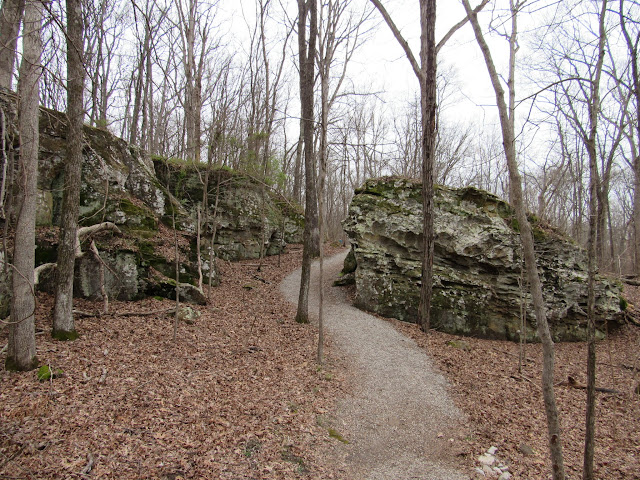Right, time to finish up that Mason/Fulton County trip I did a few weeks ago. You can read about the part where we visited Revis Hill Prairie here. We stopped to eat lunch afterwards, at Chautauqua National Wildlife Refuge. This gave us a good idea exactly how flooded the river was, as the lake was considerably higher than the last time I was there.
A few Ruddy Ducks (Oxyura jamaicensis) slept in the middle of the lake as we sat eating our lunch.
A couple of Northern Shovelers (Anas clyptea) flew by, too, showing off all their colors.
Several Red-eared Sliders (Trachemys scripta) sat in the muddy water. This lake, I've been told, used to be much fuller of fish and more scenic before the government put a levee across the middle. That and the introduction of Asian carp to these waters seems to have worsened the water quality. Still, even in a reduced state it's an appreciable place for nature.
Several American White Pelicans (Pelecanus erthrorhynchos) sat out on sandbars, and one flew right over our heads. The majority of people with me weren't birdwatchers, but pelicans are a bird everyone can appreciate, given their size and bill.
The pelican landed just behind us in a small bay, where it posed for photos. After this, we went over to Sand Ridge State Forest and into the desert of H.A. Gleason State Nature Preserve.
Two of the four of us had never been to H.A. Gleason, so we trekked over the sands.
The breeze had kicked up, and we walked through the dry grasses as they blew in the wind, north towards a tall dune named the Devil's Neck. I call this grass patch the "Devil's Prairie" as I always end up with ticks when crossing it.
Once on the Devil's Neck, we found a few small members of the Mustard family, inlcluding this Draba reptans, but one a bit rarer than the rest:
The famous Silvery Bladderpod (Lesquerella ludoviciana) while in bud, was not in flower (at the time, though on a second visit later...)
I love the giant sandbox that is this part of Mason County.
Now, I'm not going to say exactly where this tree is, but it is in the vicinity of our previous locations. The reason for this is simple- snakes like this are often taken from the wild. As a result, I will say that this is in Mason County, but no more than that.
I had walked ahead of the group, looking on the ground for snakes. Someone called out "Snake!" and I immediately ran back to see it. We had discussed the possibility that there might be some Racers in the vicinity, but as soon as I saw it, I happily screamed. "Bullsnake!" (Pituophis catenifer sayi).
Bullsnakes are the largest snake species in Illinois, and while this wasn't a big one, it was about three and a half to four feet long. They are most often seen in Illinois on the "Kankakee Sands", south of Chicago along the state's northeastern border with Indiana. The Mason County population is similar, but far less photographed by herpers. This snake resides in the sand-prairie regions of Illinois, and avoids the black-soil former prairie areas throughout most of Illinois.
This was a beautifully-patterned snake. Unfortunately, I don't have a clear photo, and they get the name Bullsnake for their aggressive-if-handled temperament. I let the snake climb higher in the tree, and both it and I were happier for it.
In the same area, we found some Corydalis flavula, a favorite of mine that I don't see near home.
A member or two of our group had never seen a wild Bald Eagle before, so I decided to show them a nest I'd found. As we approached, the Bald Eagle flew off of the nest. It wasn't a great look, but they did finally see a wild Bald Eagle!
We then went off to Emiquon, and realized quickly that while the levee-protected Thompson Lake wasn't very high, the surrounding area's floodwaters were far higher than usual!
We started watching fish in the shallows, including this Shortnose Gar (Lepisosteus platostomus) below. Obviously, I've tweaked the photo so that you can see the gar. I had never seen a gar in the wild before, and it was quite fun to watch as it cruised along the water's surface.
Far off in the distance, we spotted an Osprey (Pandion haliaetus) flying past. It dove for a fish just after this photo was taken. Ospreys may be State-endangered, but here they're an easy bird to see.
At the Emiquon Visitor's Center, several Savannah Sparrows (Passerculus sandwichensis) (named for Savannah, Georgia) hopped about in the grass on the edge of the wetland.
We saw several other interesting birds, some or all of which will be mentioned in the future. After a brief drive-about, we took a photo of the lake and left for home, stopping at Dairy Queen on the way. It was a fine end to a long day of exploring. Little did I know I'd be back the next weekend...




























































